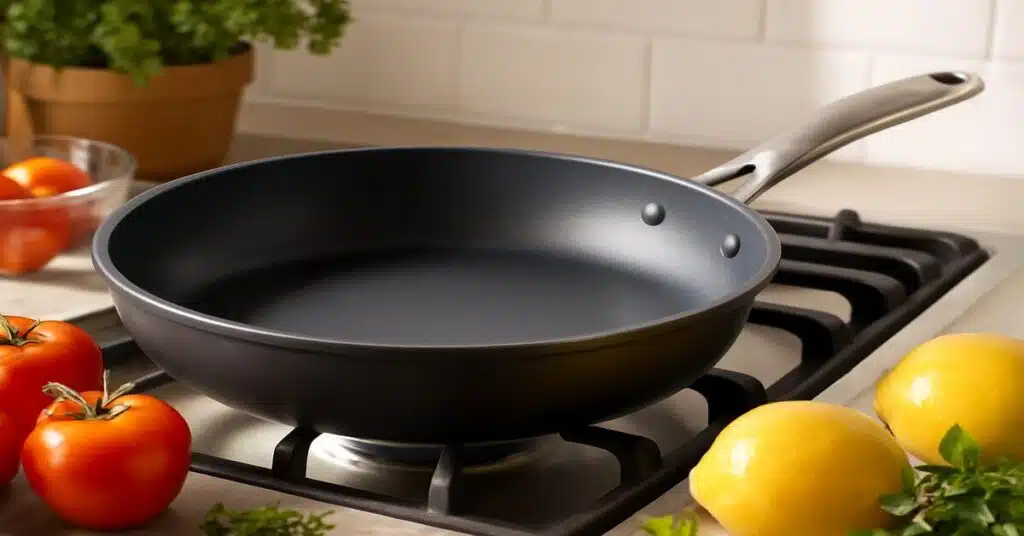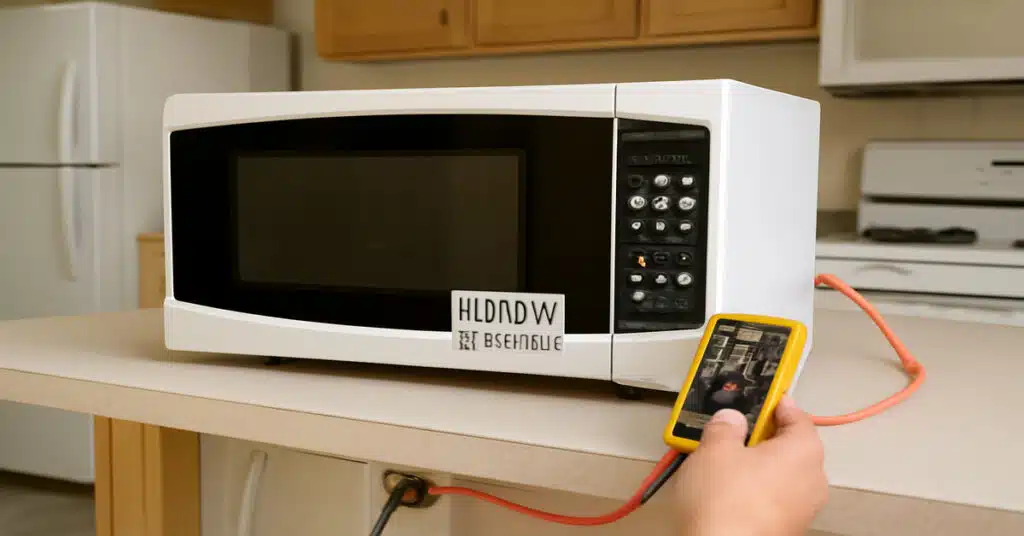A dishwasher should fit your kitchen space, clean well, and run quietly. Look for Energy Star® efficiency, trusted brands such as Bosch or Whirlpool, and a price that matches your budget and family size.
Choose Smart and Efficient Technology
Buying a dishwasher in 2025 is not only about saving time. It’s about choosing smarter, quieter, and more energy-saving machines that make daily life easier.
A good dishwasher washes every plate clean, stays under 45 dBA so it’s quiet, and carries the Energy Star® label to cut water and power bills.
What to Look For When Buying
When you shop, pay attention to:
- Capacity – How many dishes it holds.
- Noise level – Under 45 dBA is best.
- Drying performance – Ensures dishes come out spotless and dry.
- Brand reliability – Choose names known for quality service.
Top Brands in the U.S. for 2025
Well-known companies like Bosch, Whirlpool, and GE Appliances now offer smart, Wi-Fi-enabled dishwashers.
These machines have soil sensors and stainless-steel tubs that last for years and suit modern American kitchens.
Expert Tips and Local Insight
This guide was created with help from appliance technicians and real U.S. homeowners.
It compares the newest models, prices, and key features so you can pick the best dishwasher for your needs.
Prices and model options reflect large U.S. regions such as California, Texas, and New York.
👇 Let’s start by understanding how a dishwasher actually works — it’ll help you choose the right one later.
How Does a Dishwasher Work (and Why It Matters Before Buying)
A dishwasher cleans your dishes with hot water and detergent. Rotating spray arms wash every surface, while a filter traps leftover food.
After cleaning, heated air or condensation dries the dishes. Knowing this process helps you pick models that clean well and use less energy.
Step-by-Step Explanation
In most U.S. dishwashers, the wash cycle begins when 120°F (49°C) hot water fills the tub. Detergent mixes with this water, and spray arms spin quickly to remove grease and food bits.
Next, a fine filter catches debris so it doesn’t clog the drain. Then comes the rinse cycle, which adds rinse aid to stop water spots and help dishes dry faster.
Finally, a heating element or small fan warms the air to dry the dishes completely. This process saves time and uses far less water than washing by hand.
Pro Tip
According to the U.S. Department of Energy, modern Energy Star® dishwashers use about 3.5 gallons of water per cycle—around 75% less than handwashing. This means lower bills and a smaller environmental impact for every household.
👉Want to understand the full cleaning cycle in detail? Read our step-by-step breakdown here: [How a Dishwasher Works].
👇 Now that you know how it works, let’s explore the different types of dishwashers available in U.S. homes.
What Are the Types of Dishwashers?
There are five main types of dishwashers commonly used in the United States:
- Built-in dishwashers – Full-size, quiet, and permanently connected to the kitchen plumbing.
- Portable dishwashers – Freestanding models that connect to a faucet and can be rolled away for storage.
- Countertop dishwashers – Small, energy-efficient units for apartments, dorms, or RVs.
- Drawer dishwashers – Sleek and modern designs with one or two drawers for smaller loads.
- Compact (18-inch) dishwashers – Narrow models designed for tight spaces such as condos or small homes.
Each type serves different kitchen sizes, lifestyles, and budgets — helping you choose the best dishwasher for your home.
Quick Comparison Table
| Type | Ideal For | Key Features | Avg. U.S. Price |
| Built-in | Family kitchens | Full-size, quiet, Energy Star certified | $500–$1,200 |
| Portable (Freestanding) | Renters or small apartments | Connects to faucet, easy to move | $400–$800 |
| Countertop | Studios, dorms, RVs | Compact, energy-efficient, 4–6 place settings | $250–$500 |
| Drawer Dishwasher | Modern kitchens | Separate cycles, sleek design | $900–$1,500 |
| Compact (18-inch) | Tight spaces | Slim width, 8–10 place settings | $400–$700 |
Detailed Comparison
Built-in Dishwashers:
The most popular type in U.S. homes. These are quiet, durable, and ideal for families who cook often.
Portable Dishwashers:
Perfect for renters or apartments without built-in plumbing. They connect easily to a sink and can be moved when not in use.
👉 Learn more about choosing the [best portable dishwasher for small kitchens].
Countertop Dishwashers:
Best for small spaces like RVs or studio apartments. They use less water and power while offering quick cleaning cycles.
👉 Discover our expert picks for the [best countertop dishwashers in 2025].
Drawer Dishwashers:
Stylish and flexible. You can wash smaller loads separately, which saves both water and energy.
Compact Dishwashers:
Great for condos or tight kitchens. Though smaller, they still handle everyday family dishes efficiently.
Pro Tip
According to Energy Star®, compact and countertop dishwashers can use up to 65% less water than handwashing — making them ideal for urban U.S. households that want to save energy and space.
Not sure which one suits your home best?
👉 Read our detailed comparison on [Portable vs Built-in Dishwashers] to find out which type fits your kitchen and lifestyle.
👇 Once you know the types, it’s time to decide which size fits your kitchen perfectly.
Standard Dishwasher Size & Capacity Guide
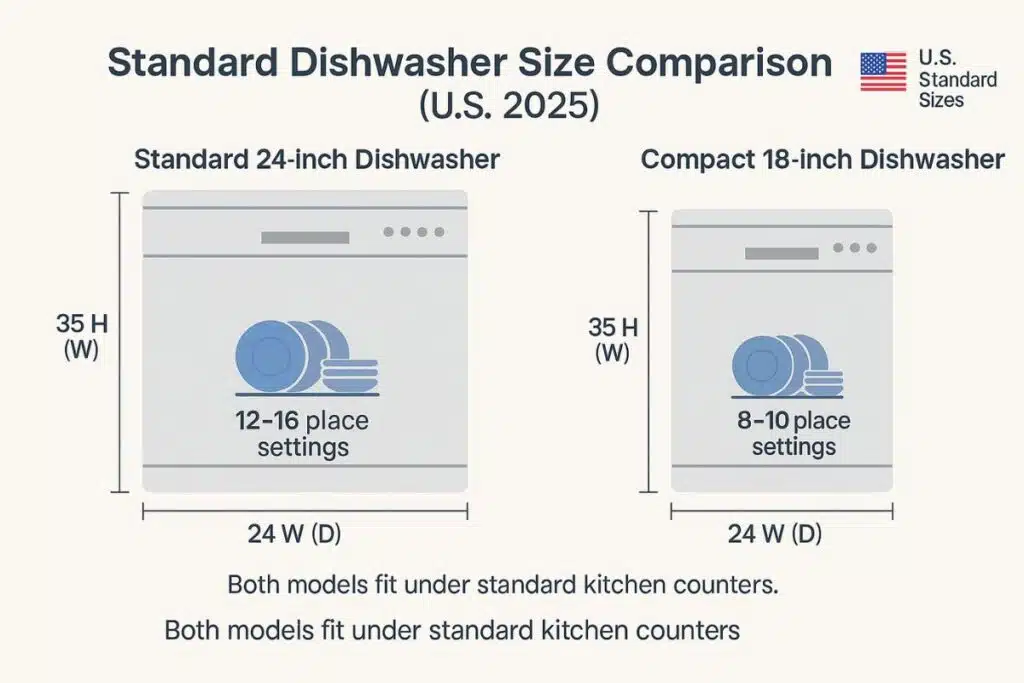
Will a 24-inch Dishwasher Fit in a Small Kitchen?
Yes. A 24-inch built-in dishwasher fits under most standard U.S. kitchen counters. If your kitchen is small, an 18-inch compact dishwasher is a better option — it cleans just as effectively, saves space, and fits most apartment layouts.
Standard U.S. Dishwasher Dimensions
| Dishwasher Type | Width | Height | Capacity | Ideal For |
| Standard Built-in | 24 in | 35 in | 12–16 place settings | Family kitchens |
| Compact (18-inch) | 18 in | 35 in | 8–10 place settings | Apartments, condos |
| Countertop | 22 in | 17 in | 4–6 place settings | Studios, dorms, RVs |
| Drawer | 24 in | 16 in per drawer | Variable | Modern small kitchens |
Detailed Overview
In the United States, 24-inch built-in dishwashers are considered the standard size.
They fit neatly under most kitchen counters and can hold 12 to 16 place settings, making them ideal for medium to large families.
For smaller kitchens, 18-inch compact dishwashers are a top pick.They hold 8 to 10 place settings, save space, and offer the same cleaning power as full-size models.
Countertop dishwashers are perfect for dorms, RVs, or single users — using minimal water while connecting easily to a sink faucet.
Meanwhile, drawer dishwashers offer modern flexibility, letting you wash smaller loads separately to save time and energy.
Installation & Measurement Tips
- Measure cabinet width, height, and depth before buying.
- Keep at least 1 inch of ventilation space on both sides.
- Check water line and power outlet placement to ensure easy installation.
- For built-in models, confirm drainage clearance behind the unit.
Buying Tip:
Measure twice before ordering — even a small mismatch can stop your dishwasher from sliding into place.
Expert Insight
According to the U.S. Department of Energy, compact dishwashers can use up to 20% less water and energy than standard models — making them ideal for urban U.S. households where space and utility savings matter.
For more details on environmental regulations and appliance efficiency standards, visit the U.S. Environmental Protection Agency (EPA) official site
Want to make sure your new appliance fits perfectly?
👉 Check our detailed guide on [Standard Dishwasher Size and Capacity] to learn the exact U.S. dimensions before buying.
👇 Choosing the right size is just step one — next, let’s explore the key features that make cleaning efficient and quiet.
Key Features You Should Look for in a Dishwasher
When buying a dishwasher in 2025, focus on features that improve performance, save energy, and make your kitchen smarter.
The most important ones include Energy Star efficiency, low noise levels, a stainless-steel tub, soil sensors, adjustable racks, and Wi-Fi connectivity — each designed to make cleaning faster, quieter, and more efficient for U.S. homes.
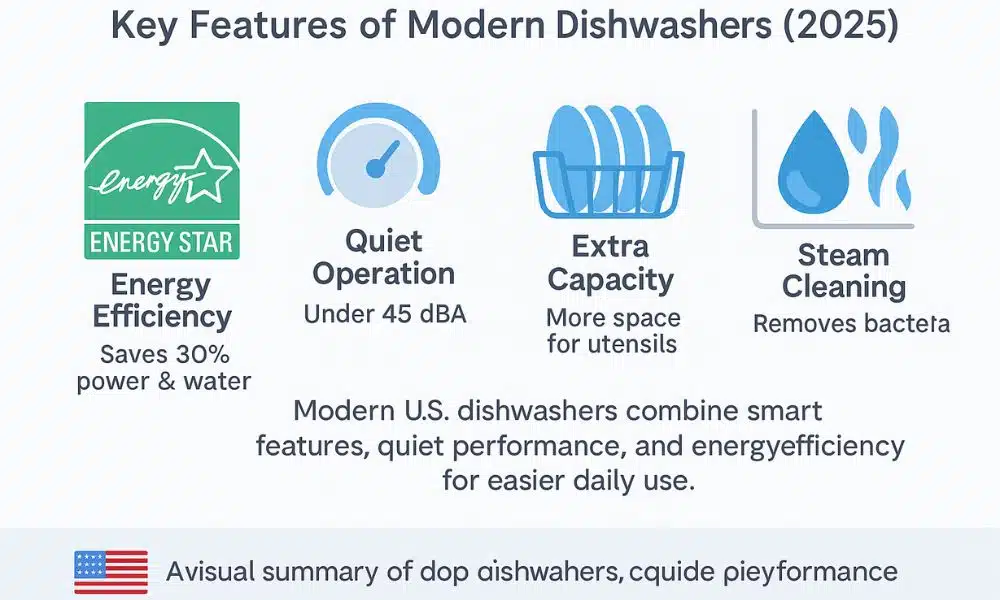
Top Dishwasher Features Explained
Energy Star Efficiency
Look for an Energy Star–certified dishwasher. It uses about 30% less water and electricity than older or non-certified models. According to Energy Star (U.S.), upgrading to a certified model can save around $55 a year while lowering your home’s carbon footprint.
👉 Explore our best energy-efficient dishwashers for 2025 to save power and water.
Noise Level (dBA Rating)
For quiet operation, choose a dishwasher rated below 45 dBA. Models from Bosch, LG, and KitchenAid run as low as 40–42 dBA, making them ideal for open-concept kitchens and small apartments.
Stainless-Steel Tub
A stainless-steel interior is stronger and cleaner than plastic. It resists odor buildup, dries faster by holding heat, and lasts longer — a key feature for families who use the dishwasher daily.
Soil Sensor Technology
A soil sensor automatically detects how dirty the dishes are and adjusts water pressure and cycle time. This ensures spotless results while saving energy and water — great for eco-conscious households.
Third Rack and Adjustable Racks
A third rack provides extra room for utensils and mugs. Adjustable racks help fit tall cookware or delicate glassware without wasting space. These features maximize capacity without increasing dishwasher size.
Smart Wi-Fi Connectivity
Smart dishwashers connect with Alexa, Google Home, or mobile apps, allowing you to:
- Start or pause wash cycles remotely
- Receive maintenance alerts
- Track energy and water usage in real time
This feature turns your dishwasher into a fully connected smart appliance.
Steam Cleaning Function
Steam cleaning uses high heat to remove grease and bacteria from dishes. It’s ideal for families with infants or anyone wanting a deep, hygienic clean without harsh detergents.
Expert Insight
In the United States, all Energy Star–certified dishwashers are tested by independent labs for energy use, water consumption, and cleaning quality. Always check for the Energy Star label — it ensures your dishwasher meets official U.S. efficiency standards for 2025.
👇 Once you know what to look for, installing your dishwasher the right way ensures it works safely and efficiently.
How Much Does It Cost to Install a Dishwasher?

In the United States, the average cost to install a dishwasher is $150–$300, depending on plumbing, wiring, and labor rates.
DIY installation can save around $100, but it may void your warranty if done incorrectly. Most professional installations take 1.5–2.5 hours, including setup and testing.
Quick Tip:
Older homes or custom kitchens may need extra plumbing or electrical work, which can increase installation costs.
Dishwasher Installation Guide Step-by-Step
Installing your dishwasher correctly ensures efficiency, safety, and a longer lifespan.
Follow these simple steps for a smooth setup:
- Turn Off Power and Water Supply
Disconnect power and close the main water valve before you start. - Measure the Cabinet Opening
Standard dishwashers fit in a 24-inch wide and 34–35 inch high under-counter space. - Connect the Water Inlet Hose
Attach the inlet hose to the hot-water line and seal it securely with Teflon tape. - Attach the Drain Hose
Connect it to the sink drain or garbage disposal and secure it tightly to prevent leaks. - Plug In or Hardwire the Power
Follow your manufacturer’s instructions — some dishwashers plug into outlets, others need direct wiring. - Level the Dishwasher
Adjust the legs so the unit sits evenly. An uneven base can cause leaks or loud vibration. - Run a Test Cycle
Turn on the power and water, then run a short cycle to check for leaks, noise, or drainage issues.
Expert Insight
If your home has old copper pipes or outdated electrical systems, hire a licensed plumber or electrician. According to the U.S. Department of Energy, professional installation improves performance by up to 15% and reduces the risk of leaks or electrical faults.
Across the U.S., stores like Home Depot, Lowe’s, and Best Buy offer flat-rate installation services between $150–$300, which include setup, testing, and haul-away of old units.
Average Dishwasher Installation Cost Breakdown
| Installation Type | Avg. U.S. Cost | Time Required | Key Details |
| Standard Professional Install | $150–$300 | 1.5–2.5 hrs | Includes water and power hookup |
| DIY Installation | $50–$100 | 2–3 hrs | Cheaper but may void warranty |
| Replacement Installation | $100–$200 | 1–2 hrs | Uses existing plumbing lines |
| Full Remodel Installation | $250–$500 | 3–4 hrs | Requires new plumbing and wiring |
Installation & Measurement Checklist
Before starting your setup, make sure you:
✅ Have a grounded electrical outlet nearby
✅ Leave 1 inch of clearance on each side for ventilation
✅ Keep the drain hose looped above the floor to prevent backflow
✅ Use anti-tip brackets for safety
✅ Test the dishwasher before pushing it into place
Need a full step-by-step setup tutorial?
👉 Follow our complete guide on [How to Install a Dishwasher] to connect water lines, wiring, and drainage safely at home.
👇 Installation complete? Now let’s break down price tiers so you know what to expect when shopping in 2025.
What Are the Dishwasher Price Ranges in 2025?
In 2025, dishwasher prices in the U.S. range from $350 to $1,600+, depending on size, brand, and smart features.
Budget dishwashers under $500 handle basic cleaning. Meanwhile, mid-range and luxury models offer quiet operation, smart Wi-Fi, and sleek stainless-steel finishes — making them ideal for modern American kitchens.
Quick Tip:
Before making a purchase, compare prices at Home Depot, Lowe’s, and Best Buy. Because prices often vary by region — mainly due to labor costs and state rebate programs.
Dishwasher Price Comparison Table
| Price Range | Key Features | Top Models (2025) |
| Under $500 (Budget) | Basic cycles, plastic tub, 55–60 dBA | GE GDF550PGRWW, Frigidaire FDPC4221AS |
| $500 – $1000 (Mid-Range) | Stainless tub, Energy Star, 45–50 dBA, multiple wash options | Whirlpool WDT730, LG LDF5545ST |
| $1000+ (Luxury) | Smart Wi-Fi, touchscreen, <42 dBA, premium finish | Bosch 800 Series, KitchenAid KDTE204KPS |
Under $500 — Budget-Friendly Dishwashers
These entry-level models are ideal for small homes or renters.
Units like GE GDF550PGRWW and Frigidaire FDPC4221AS deliver strong cleaning and reliable drying without premium cost.
Most operate at around 55–60 dBA, slightly louder but energy-efficient for light daily use.Budget dishwasher, GE, Frigidaire, Energy Star, plastic tub.
👉“For affordable options that still deliver solid performance, check out our guide to [Best Dishwashers Under $500]. It’s ideal for small homes, renters, and budget-conscious buyers.
$500 – $1000 — Best Value for Families
This mid-range segment is the most popular among U.S. households.
You’ll find stainless-steel tubs, quiet cycles (under 50 dBA), and adjustable racks for better capacity.
Models like Whirlpool WDT730 and LG LDF5545ST combine solid durability with energy savings — perfect for medium-sized families.Whirlpool, LG, stainless-steel dishwasher, quiet model, mid-range.
Looking for more advanced features without going premium?
👉 Check out our list of [Best Dishwashers Under $1000] to compare mid-range models with quiet operation and Energy Star ratings.
$1000+ — Premium and Smart Dishwashers
Top-tier dishwashers are built for design and silence.
The Bosch 800 Series and KitchenAid KDTE204KPS feature Wi-Fi control, touch sensors, and ultra-quiet performance (below 42 dBA).
These luxury models suit open-concept kitchens and smart homes where convenience meets aesthetics. Verified by Consumer Reports and Energy Star U.S. for efficiency, performance, and long-term reliability.
Pro Insight
According to the U.S. Department of Energy, Energy Star-certified dishwashers save up to 30% on electricity and water use annually.
States like California, Texas, and Illinois offer rebates for upgrading to certified models — a great way to lower total cost of ownership.
👇 With your budget clear, you’re ready to explore the top-rated dishwasher models trusted by U.S. buyers.
What Are the Best Dishwasher Models by Type in 2025?
The best dishwashers in 2025 combine quiet operation, Energy Star efficiency, and smart Wi-Fi control.
Top-rated models include Bosch 300 Series, GE Profile PDT755SYRFS, Whirlpool WDT730PAHZ, LG LDP6810SS, and KitchenAid KDTE204KPS — each recognized by Energy Star® and reviewed by Consumer Reports (U.S.) for long-term reliability and performance.
Quick Tip:
For the quietest experience, choose the KitchenAid KDTE204KPS (39 dBA) — ideal for open-concept U.S. kitchens.
Best Dishwashers by Type — 2025 Comparison
Bosch 300 Series SHEM63W55N (Built-in)
- Noise: 44 dBA (ultra-quiet)
- Capacity: 16 place settings
- Features: Stainless-steel tub, third rack, PrecisionWash sensor
- Price Range: $900 – $1,000
✅ Best for families wanting premium quality and silence.
👉 Check Price on Amazon
GE Profile PDT755SYRFS (Top-Control)
- Noise: 45 dBA
- Capacity: 15 place settings
- Features: Wi-Fi, hard-food disposer, sanitize cycle
- Price Range: $800 – $950
✅ Perfect for busy homes that need smart cleaning and reliable cycles.
👉 View on Amazon
Whirlpool WDT730PAHZ (Front-Control)
- Noise: 51 dBA
- Capacity: 14 place settings
- Features: Soil sensor, Energy Star certified, adjustable racks
- Price Range: $650 – $750
✅ Dependable mid-range option for most U.S. kitchens.
👉 See Price on Amazon
LG LDP6810SS (Smart Dishwasher)
- Noise: 44 dBA
- Capacity: 15 place settings
- Features: SmartThinQ Wi-Fi, QuadWash, TrueSteam drying
- Price Range: $950 – $1,100
✅ Ideal for tech-savvy users who love smart control and fast drying.
👉 Buy on Amazon
KitchenAid KDTE204KPS (Quiet Series)
- Noise: 39 dBA (super quiet)
- Capacity: 16 place settings
- Features: Pro Wash cycle, stainless steel interior, adjustable racks
- Price Range: $1,000 – $1,200
✅ Best for open-concept homes where silence matters most.
👉 View on Amazon
Expert Insight
According to Consumer Reports (U.S.), Bosch and KitchenAid lead 2025 dishwasher reliability rankings.
All five models carry Energy Star® certification, qualifying for state-specific rebates in California, Texas, and New York.
Pro Tip:
Compare prices on Amazon, Home Depot, and Best Buy before purchasing — regional promotions often save 10–15%.
Which Dishwasher Brand Is Most Reliable?
The most reliable dishwasher brands in 2025 are Bosch, Whirlpool, and LG — known for long-lasting performance, low noise, and Energy Star® efficiency. According to Consumer Reports (U.S.), Bosch dishwashers last 12–15 years with proper maintenance and are rated ★★★★★ for overall reliability.
Quick Tip:
If you prefer quiet performance, KitchenAid and LG models under 45 dBA are excellent for open-concept U.S. kitchens.
Avoid Frigidaire and Maytag models if you want long-term durability.
👇 After checking the models, it’s worth knowing which brands are truly reliable — and which to skip.
Dishwasher Brand Reliability & Noise Comparison (2025)
| Brand | Reliability (2025) | Avg Noise (dBA) | Verdict |
| Bosch | ★★★★★ | 42 | ✅ Best Overall |
| Whirlpool | ★★★★☆ | 50 | 👍 Great Value |
| LG | ★★★★☆ | 44 | ✅ Smart Choice |
| GE Appliances | ★★★★☆ | 48 | 👍 Reliable Option |
| KitchenAid | ★★★★☆ | 39 | ✅ Premium Pick |
| Frigidaire | ★★★☆☆ | 55 | ⚠️ Budget Only |
| Maytag | ★★★☆☆ | 52 | ⚠️ Noisy / Basic |
Expert Insight
Technicians across the United States note that Bosch and Whirlpool dishwashers are the easiest to service and maintain — reducing lifetime repair costs.
Energy Star-certified models from these brands use up to 30 % less water and power, meeting 2025 U.S. energy-efficiency standards.
These brands are widely available at Home Depot, Lowe’s, and Best Buy across major U.S. states like California, Texas, and New York. To see updated dishwasher performance rankings, check Good Housekeeping’s expert-tested dishwasher reviews.
🚫 Brands to Avoid in 2025
- Frigidaire — Budget-friendly but limited cycles and shorter lifespan.
- Maytag — Durable build yet noisy and less energy-efficient.
- Insignia / Beko — Limited parts and service availability in the U.S.
Want to know which brands consistently score highest for reliability and performance?
👉 Explore our expert-reviewed list of [Best Dishwasher Brands] to find out which ones are worth your investment in 2025.
👇 Once you’ve picked a reliable brand, proper maintenance will help it last longer and perform better.
How Often Should You Clean Your Dishwasher?
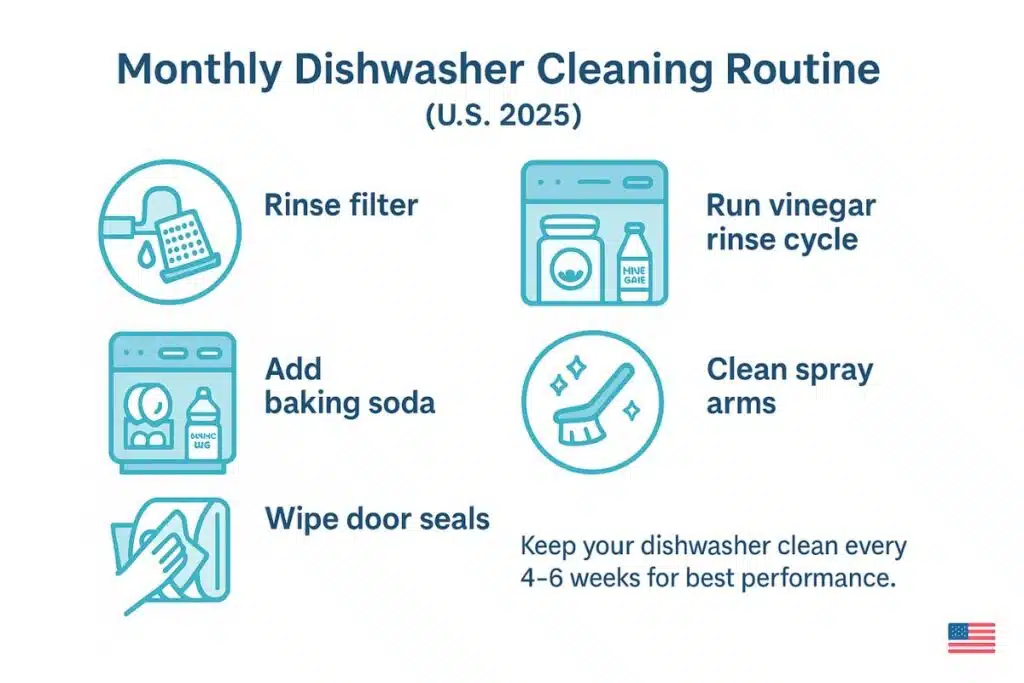
Clean your dishwasher every 4–6 weeks to keep it running efficiently.
Remove and rinse the filter, wipe the rubber door seals, and run a vinegar rinse cycle to remove grease, detergent residue, and odors. Regular cleaning prevents limescale buildup and extends your dishwasher’s lifespan.
Dishwasher Cleaning Routine Step-by-Step
Follow these simple steps once a month for best performance:
Clean the Filter
Remove the bottom rack, unscrew the filter, and rinse it under warm water to remove food particles.
Run a Vinegar Cycle
Pour one cup of white vinegar into a dishwasher-safe bowl and place it on the top rack.
Run a full hot-water cycle to break down grease and remove detergent residue.
Deodorize with Baking Soda
Sprinkle one cup of baking soda at the bottom of the tub and run a short hot cycle for a fresh smell.
Wipe the Door Seals
Use a soft cloth to clean the rubber gaskets around the door to prevent mold or mildew buildup.
Check the Spray Arms
Inspect holes for clogs and clean them gently with a brush or toothpick to ensure smooth water flow.
Expert Tip
In areas with hard water—such as Arizona, Nevada, and Texas—use a rinse aid or water softener to prevent mineral buildup. According to U.S. appliance technicians, this can extend dishwasher life by up to two years.
Dishwasher Maintenance Checklist
✅ Clean the filter monthly
✅ Run a vinegar rinse cycle
✅ Use baking soda for deodorizing
✅ Check spray arms and seals regularly
✅ Avoid overloading the dishwasher
Want a detailed monthly cleaning routine with expert tips?
👉 Check out our full [Dishwasher Maintenance Guide] to keep your appliance running efficiently and extend its lifespan.
👇 Even with great care, buying mistakes can happen — let’s see what to avoid before making your final choice.
What Are the Common Mistakes to Avoid When Buying a Dishwasher?
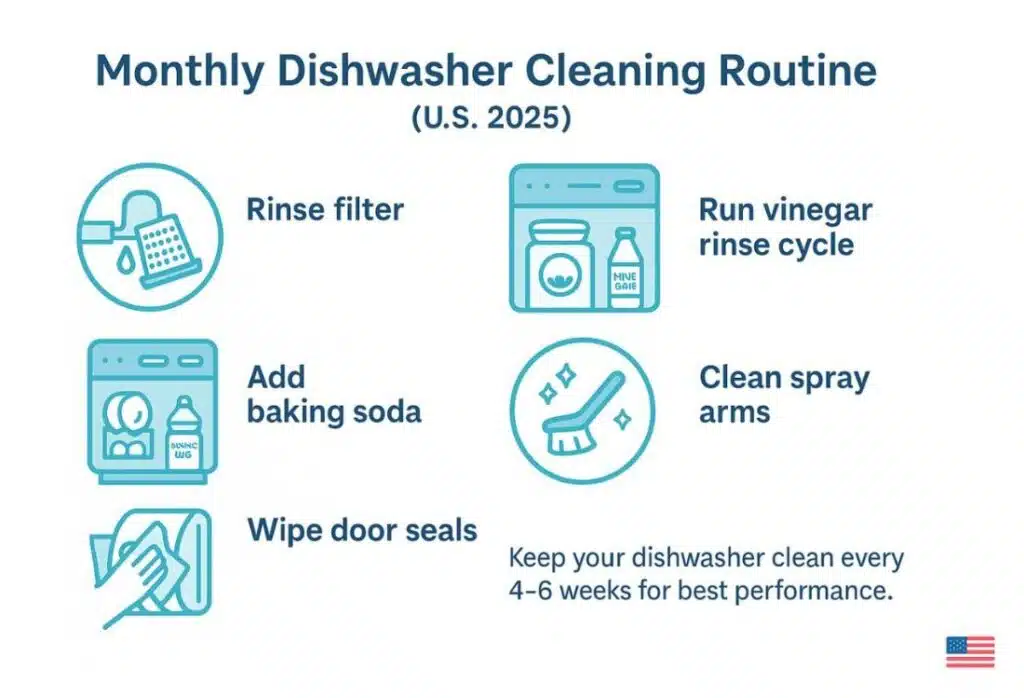
The most common mistakes when buying a dishwasher include:
- Ignoring noise level (dBA): Avoid models above 50 dBA — they’re too loud for open kitchens.
- Buying the wrong size: Always measure your cabinet before purchase; the standard U.S. width is 24 inches.
- Skipping Energy Star certification: Non-certified dishwashers waste more water and electricity.
- Overpaying for features: Smart Wi-Fi or LED panels aren’t necessary for every home.
- Forgetting warranty and repair coverage: Check if local service centers are available.
- Neglecting proper installation: Improper setup causes leaks and drainage problems later.
Quick Tip: Before buying, check three things — noise level, Energy Star label, and size fit. These details prevent 80% of buyer mistakes.
Detailed Breakdown
Noise Level (dBA)
Quiet dishwashers operate under 45 dBA — ideal for open kitchens and small apartments.
Size & Fit
Standard built-in = 24 inches wide, while compact = 18 inches. Measure your space twice before ordering.
Energy Efficiency
An Energy Star–certified model uses up to 30% less water and power, lowering utility bills and helping the environment.
Smart Features
Only choose smart models if you’ll truly use app controls or Wi-Fi scheduling — otherwise, it’s an unnecessary cost.
Warranty & Service Support
Brands like Bosch, Whirlpool, and LG have wide U.S. service networks — choose one that offers easy part replacement.
Installation Quality
According to U.S. repair data, 40% of dishwasher failures come from bad installation or loose hoses — not manufacturing faults.
Expert Insight
Consumer Reports (U.S.) confirms that brands like Bosch and Whirlpool are among the most reliable, lasting 10–15 years when properly installed. Professional installers from Home Depot or Best Buy ensure proper setup and prevent water damage — essential for warranty safety.
Smart Buyer Checklist
- Noise level under 45 dBA
- Energy Star certification
- Proper 24” or 18” fit
- Warranty + service access
- Avoid unnecessary smart features
- Hire a professional installer
Before you make your final purchase, make sure you’re not falling for common buyer errors.
👉 Read our full guide on [Dishwasher Common Mistakes] to learn what to avoid and how to buy smart in 2025.
👇 Avoiding these mistakes ensures smarter shopping. Let’s wrap up with expert advice and next steps.
What’s the Best Way to Choose the Right Dishwasher for Your Home in 2025?
Choosing the right dishwasher in 2025 means finding the balance between budget, space, and energy efficiency.
Whether you prefer a quiet Bosch 300 Series, a dependable Whirlpool, or a smart LG, focus on these three essentials:
- Energy Star efficiency – saves electricity and water.
- Proper capacity fit – 18-inch for small kitchens, 24-inch for families.
- Long-term reliability – verified brand performance and service coverage.
Check verified U.S. retailer reviews and Energy Star 2025 performance data before purchasing. A well-chosen dishwasher will last over a decade while cutting annual utility bills.
Looking for models that balance quality and price?
👉 Compare today’s [best dishwashers under $1000] — featuring top-rated picks from Bosch, Whirlpool, and LG, all verified by Energy Star 2025 performance data.
👉 For affordable options that still perform well, explore our guide to [Best Dishwashers Under $500] — perfect for small homes and budget buyers.
All insights — prices, models, and energy data — come from verified U.S. retailers and Energy Star 2025 reports.
👇 Got more questions? Our FAQ section below clears every confusion before you buy.
FAQs Dishwasher Buying Guide 2025
What is a good noise level for a dishwasher?
A dishwasher under 45 dBA is considered quiet and ideal for open-concept kitchens. Models like Bosch and LG operate around 40–42 dBA, making them nearly silent.
How long should a dishwasher last?
Most modern dishwashers last 10 to 15 years, depending on brand, usage, and maintenance. Regular cleaning of filters and seals extends lifespan.
👉 Learn step-by-step cleaning tips in our [Dishwasher Maintenance Guide].
How much does it cost to install a dishwasher in the U.S.?
Professional installation typically costs $150–$300, depending on plumbing and wiring. DIY installation is cheaper but can void warranties.
👉 For full instructions and cost breakdown, visit our [Dishwasher Installation & Setup Guide].
Which dishwasher brand is the most reliable in 2025?
According to Consumer Reports, Bosch and Whirlpool are the most reliable dishwasher brands in the U.S., lasting 12–15 years with proper care.
👉 Compare performance, noise levels, and warranty coverage in our [Best Dishwasher Brands 2025 Review].
What are the top features to look for in a dishwasher?
Look for Energy Star certification, stainless-steel tub, Wi-Fi connectivity, and soil sensor technology for the best performance.
How often should I clean my dishwasher?
Clean your dishwasher every 4–6 weeks. Rinse the filter, wipe the door gasket, and run a vinegar cycle to remove buildup and odor.
Plastic vs Stainless Steel Dishwasher Tub — Which Is Best?
A stainless steel dishwasher tub is usually the better choice for most U.S. homes. It’s quieter, more durable, and dries dishes faster than plastic tubs. However, plastic tubs are cheaper and lightweight, making them ideal for budget-friendly dishwashers.
👉 Learn the full comparison in our detailed guide —
Plastic vs Stainless Steel Dishwasher Tub: Which Is Right for You?
About the Author:
Soazim is a home appliance researcher and editor at KitchenPluse.com, specializing in dishwasher technology and kitchen efficiency. He studies U.S. market trends, Energy Star ratings, and real-user feedback to help homeowners choose the most efficient and durable dishwashers. His work blends hands-on testing with clear, data-backed buying insights trusted by readers across the U.S.


